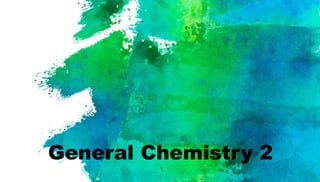gen_chem_boyle_s_law.pptx
•Download as PPTX, PDF•
0 likes•3 views
boyle's law
Report
Share
Report
Share

Recommended
Recommended
More Related Content
Similar to gen_chem_boyle_s_law.pptx
Similar to gen_chem_boyle_s_law.pptx (20)
Physics II Lecture thermodynamics and ideal gas equation

Physics II Lecture thermodynamics and ideal gas equation
Recently uploaded
Recently uploaded (20)
Thyroid Physiology_Dr.E. Muralinath_ Associate Professor

Thyroid Physiology_Dr.E. Muralinath_ Associate Professor
development of diagnostic enzyme assay to detect leuser virus

development of diagnostic enzyme assay to detect leuser virus
Porella : features, morphology, anatomy, reproduction etc.

Porella : features, morphology, anatomy, reproduction etc.
Human & Veterinary Respiratory Physilogy_DR.E.Muralinath_Associate Professor....

Human & Veterinary Respiratory Physilogy_DR.E.Muralinath_Associate Professor....
GBSN - Biochemistry (Unit 2) Basic concept of organic chemistry 

GBSN - Biochemistry (Unit 2) Basic concept of organic chemistry
FAIRSpectra - Enabling the FAIRification of Spectroscopy and Spectrometry

FAIRSpectra - Enabling the FAIRification of Spectroscopy and Spectrometry
The Mariana Trench remarkable geological features on Earth.pptx

The Mariana Trench remarkable geological features on Earth.pptx
FAIRSpectra - Enabling the FAIRification of Analytical Science

FAIRSpectra - Enabling the FAIRification of Analytical Science
Pteris : features, anatomy, morphology and lifecycle

Pteris : features, anatomy, morphology and lifecycle
X-rays from a Central “Exhaust Vent” of the Galactic Center Chimney

X-rays from a Central “Exhaust Vent” of the Galactic Center Chimney
gen_chem_boyle_s_law.pptx
- 2. The result of many of these molecular collisions is pressure. PRESSURE is the force exerted per unit area by gas molecules as they strike the surfaces around them.
- 3. •Gases are composed of particles that are moving around very fast in their container(s). •These particles move in straight lines until they collides with either the container wall or another particle, then they bounce off. •Gas pressure is a result of the constant movement of the gas molecules and their collisions with the surfaces around them.
- 4. BOYLE’S The relationship between pressure and volume of gases.
- 6. BOYLE’S States that in constant temperature and amount of molecules, the pressure of a fixed quantity of a gas varies inversely with the volume. P1V1 = P2V2
- 7. As the volume of a gas sample is decreased, gas molecules collide with surrounding surfaces more frequently, resulting in greater pressure.
- 8. •This law is named for Charles Boyle, who studied the relationship between pressure and volume of a gas. •Boyle determined that for the same amount of a gas at constant temperature, results in an inverse relationship: when one goes up, the other comes down. BOYLE’S
- 9. 9
- 10. Organize the data in a table of initial and final conditions. Rearrange the gas law to solve for unknown quantity. Substitute the values into the gas law equation to solve for the unknown.
- 11. SAMPLE PROBLEM Freon-12, CCl2F2, is used in refrigeration systems. What is the new volume (L) of a 8.0 L sample of Freon gas initially at 550 mmHg after its pressure is changed to 2200 mmHg at constant T? 11 2.0 L
- 12. SAMPLE PROBLEM Air trapped in a cylinder fitted with a piston occupies 145.7 mL at 1.08 atm pressure. What is the new volume when the piston is depressed, increasing the pressure by 25%? 12 ?
- 13. PROBLEM 1 A geochemist heats a limestone (CaCO3) sample and collects the CO2 released in an evacuated flask. After the system comes to room temperature, the heat produced is 291.4 mmHg. Calculate the CO2 pressure in atmospheres and kilopascals. 13 ?
- 14. PROBLEM 2 A diver blows a 0.75-L air bubble 10 m under water. As it rises to the surface, the pressure goes from 2.25 atm to 1.03 atm. What will be the volume in mL of air in the bubble at the surface? 14 ?
- 15. PROBLEM 3 The pressure of a sample of helium in a 1.00-L container is 0.988 atm. Compute the new pressure in mmHg if the sample is placed in a 200 mL container? 15 ?
- 16. PROBLEM 4 A sample of oxygen gas has a volume of 12.0 L at 600. mm Hg. What is the new pressure in atm when the volume changes to 36.0 L? 16 ?